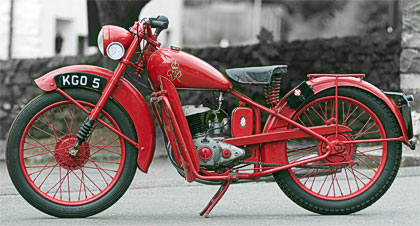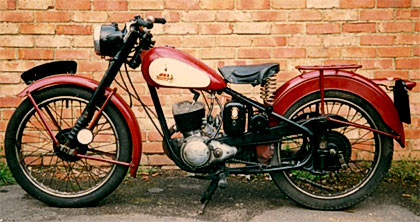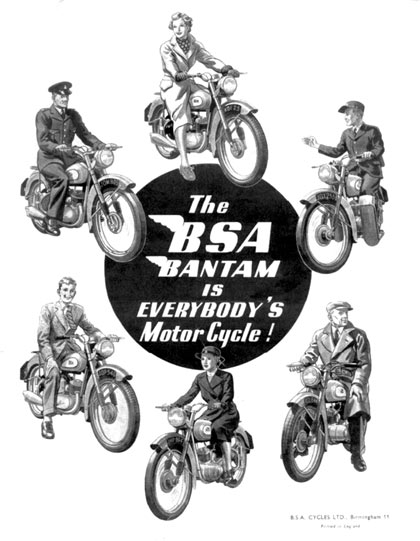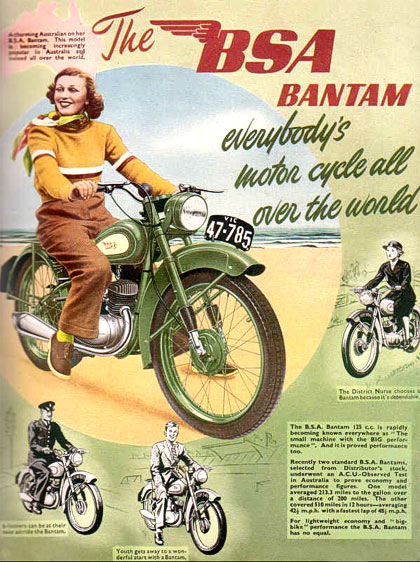There was a time when the country was buzzing with D1 Bantams, not least those owned and run by the General Post Office which for decades ran a highly efficient telegram service. Between 1948 and 1963, tens of thousands of D1s were manufactured by BSA, all following the same basic formula of a crude telescopic front end and plunger rear (rigid up until 1950), and an easily maintained 123cc single cylinder two-stroke engine in the middle. 
▲ Note the leg shields on this rigid framed BSA D1 Bantam. Essential accessories for a convincing running example or restoration project. Early telegram boys were treated in much the same way as military recruits. They were uniformed, regimented and heavily disciplined with strict codes of conduct. The first UK motorised telegram service started in Leeds in the 1930s. At its peak, around 65 million telegrams were delivered, but it was never an economically viable service and was run at a loss. As telephone ownership increased, so the need for the telegram service diminished. In 1982, when telegram deliveries could be counted in hundreds rather than thousands or tens of thousands, the service was scrapped. 
▲ Small, and not very punchy, but a perfectly viable 123cc British two-stroke engine that mobilised an army of telegram boys. For a while, the bikes were largely forgotten, except, that is, by a small core of disciples who not only loved the original D1 Bantam, but were enamoured by the bright red livery for which they were so famous. Sumpster Ian Hargrave is one such Bantam aficionado. Here's his personal account of BSA D1 ownership told in his own words. 
▲ Ian's 123cc BSA D1 Bantam as purchased in 1987. In 1950, rigid frames gave way to plungers (as seen on this example). 
Ian Hargrave's story I bought the Bantam in 1987 for £300 through a friend of mine who was a mechanic and a BSA fanatic. I had just moved in with my soon-to-be-wife and it was to be my main means of transport to work in a daily commute between Twyford and Slough, Berkshire. I rode it for 3 years, but due to the lack of a garage it had to be stored outside under a tarpaulin, and after an unfriendly first winter the Bantam began to object, refusing to start in the cold and stalling in the rain. Consequently it was reserved for more clement weather, and I was prompted to buy a Japanese bike with more modern electrics for the day to day trips to work. 
▲ Ian's 123cc BSA D1 Bantam as restored in 2013
With the bike needing more attention each time I rode it I started to have ideas on refurbishing the bike, and bringing it back to original condition. With that in mind, I began collecting parts such as new exhaust, a wiring loom, and new gaskets, and eventually the bike was completely dismantled and stored in boxes in the garage.
Then along came the children, so the project took a back seat. In 1998, however, the bike was transferred to a friend's workshop with the greatest of intentions, but that is exactly where it stayed, untouched for 15 years. Finally, in 2012, prompted by a motorbike nut of a friend, I was reminded of my prized possession. It was then that I was introduced to Paul Sands of PJS Motorcycles. With Pauls' considerable knowledge of ALL motorbikes, but especially classics such as the Bantam, the project began in earnest. It took around 6 months to put the bike together, and with the engine rebuilt by Paul, along with his very useful contacts in the business who could paint, chrome, and supply the required parts, we had a running bike by the late summer of 2013. 
▲ Ian Hargrave and his cherished BSA D1 Bantam. These are always in demand, and prices have stabilised after a lot of volatility.
The Bike
It's a D1 Plunger, first registered on 2nd September 1960. The registration number was kept by the original owner, but an age-related plate was gained from DVLA in 2012.
Only one modification has been made to the original bike in the form of electronic ignition, as this had been a source of constant frustration. The wheel hubs are original, but I did replace the rims as the pitting on the chrome was too heavy for a quality restoration. The colour is Devon Red, and is the original as can be seen, albeit very faded, in the 1987 photo. 
▲ Easy to maintain, cheap on spares, excellent fuel economy, pleasing to the eye, and a gentle two-stroke burble on the ear. Motorised transport doesn't get much simpler.
Although the original log books have long gone, I can at least verify the mileage since 1987, which was 16,000 miles, and is now around 22,000 miles.
As for expenses, this has cost around £1200 in parts, paint spraying and re-chroming. Not bad for a bike which would re-sell for a considerable amount more. The bike is not used on a daily basis, but in summer is out several times a week. As I live close to the highest point in the south of England, and in an area of outstanding natural beauty, much of the riding is done in the country lanes which is an absolute joy. The bike can buzz along at a fairly steady 40-50mph under most conditions. It will get up all the hills that I've encountered, but with the low power fed through a 3-speed gearbox doesn't have too much grunt or acceleration. Braking is 'OK' at speed, but in town traffic works well. The ride on the plunger suspension is a little bouncy but still holds the road well. 
| 
















 is a gift for someone. So if you haven't heard from us within 24 hours of placing your order, please check your spam box, or contact us again.
is a gift for someone. So if you haven't heard from us within 24 hours of placing your order, please check your spam box, or contact us again.
